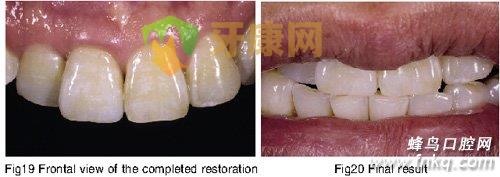口腔大全
精选推荐
Superstructures for single-tooth implants
来源:牙康网
时间:2023-09-27 17:28:24
责编:护牙顾问
人气:
In modern dental implantology, aesthetics are becoming increasingly important. Improved aesthetic results can be achieved as a result of the wider variety of materials, designs and techniques available for implant restorations today. There is also a wider selection of implant abutments, including CAD/CAM, UCLA and prefabricated abutments made of different materials such as zirconia, titanium and gold. This article describes singletooth implant cases in which aesthetic superstructures were success-fully fabricated with the IPS d.SIGN■ layering ceramic system.
In order to achieve a natural shape and contour of implant restorations, profound knowledge of the anatomy of teeth and the gingival outline is necessary. A careful examination of the horizontal sections of teeth (Fig 1) reveals that each section is unique and has a different appearance. Ceramists should consider these unique charac-teristics of dental anatomy in order to achieve a natural emergence profile which is in harmony with that of the adjacent teeth (Fig 2).
A customized abutment (UCLA abutment) must mimic the shape and contour of the natural tooth. In this case, the abutment was cast in gold and a ceramic shoulder was applied using IPS d.SIGN materials (Fig 3). In order to ensure a natural-looking gingival outline, the gingival contour on the working model had to be modified (Fig 4). After the fabrication of the customized abutment, the metal framework was created based on a reduced full-contour wax-up (Figs 5 and 6). Prior to veneering with IPS d.SIGN layering materials, the surfaces of the metal frameworks were carefully finished using crosscut tungsten carbide or ceramic-bonded burs. After having blasted the frameworks with 100 μaluminium oxide at two bar pressure and steam-cleaning them, they were ready for the first wash firing or the actual opaquer firing cycle (Figs 7 and 8).
Summary
When fabricating restorations, it is important to imitate the features of natural teeth. The root and the shape in the cervical area require particular attention when implant-borne restorations are made. Never -theless, the fabrication of implant-retained restorations has been difficult to date, as the metal imposes certain limitations.
Fortunately, a number of manufacturers have developed new materials which open up new possibilities and thus enable results to be achieved that are satisfactory for all the parties involved.
In particular the IPS d.SIGN materials provide outstanding properties which allow the natural tooth shade to be precisely mimicked (Figs 19 and 20).
Consequently, the fabrication of aesthetically pleasing, implant-supported restorations has become considerably easier, as suitable materials are available for each individual case




In order to achieve a natural shape and contour of implant restorations, profound knowledge of the anatomy of teeth and the gingival outline is necessary. A careful examination of the horizontal sections of teeth (Fig 1) reveals that each section is unique and has a different appearance. Ceramists should consider these unique charac-teristics of dental anatomy in order to achieve a natural emergence profile which is in harmony with that of the adjacent teeth (Fig 2).
A customized abutment (UCLA abutment) must mimic the shape and contour of the natural tooth. In this case, the abutment was cast in gold and a ceramic shoulder was applied using IPS d.SIGN materials (Fig 3). In order to ensure a natural-looking gingival outline, the gingival contour on the working model had to be modified (Fig 4). After the fabrication of the customized abutment, the metal framework was created based on a reduced full-contour wax-up (Figs 5 and 6). Prior to veneering with IPS d.SIGN layering materials, the surfaces of the metal frameworks were carefully finished using crosscut tungsten carbide or ceramic-bonded burs. After having blasted the frameworks with 100 μaluminium oxide at two bar pressure and steam-cleaning them, they were ready for the first wash firing or the actual opaquer firing cycle (Figs 7 and 8).



Following this,the fluorapatite glass ceramic materials were built up. After contouring and finishing, surface texture was applied. Finally the restoration was glazed and polished. This is only briefly shown here by means of the Figures 9 to 18.
Summary
When fabricating restorations, it is important to imitate the features of natural teeth. The root and the shape in the cervical area require particular attention when implant-borne restorations are made. Never -theless, the fabrication of implant-retained restorations has been difficult to date, as the metal imposes certain limitations.
Fortunately, a number of manufacturers have developed new materials which open up new possibilities and thus enable results to be achieved that are satisfactory for all the parties involved.
In particular the IPS d.SIGN materials provide outstanding properties which allow the natural tooth shade to be precisely mimicked (Figs 19 and 20).
Consequently, the fabrication of aesthetically pleasing, implant-supported restorations has become considerably easier, as suitable materials are available for each individual case
相关阅读:
为您推荐:
猜您喜欢:
- 牙髓炎吃了布洛芬睡一觉好了?急性牙
- 德国树脂补牙材料和美国3M树脂补牙
- 做种植牙有哪些优缺点
- 美白镶烤瓷牙可能会伤神经
- 牙齿矫正会一直疼痛吗?牙齿矫正就诊
- 做种植牙有哪些步骤
- 牙齿美容四步走
- 那些情况下的乳牙需要拔除
- 宝宝有牙渍 易患牙龈炎
- 茶渍牙怎么治疗
- 种植牙使用年限有多久
- 哪三种情况需要做烤瓷牙
- 推荐几种美白牙齿的方法
- 二氧化锆全瓷牙好吗
- 做了烤瓷为何刷牙还要出血
- 牙齿烤瓷牙危害一般有哪些
- 烤瓷补牙有哪些优点
- 烤瓷牙的配色统计
- 单颗后牙种植(视频)
- 烤瓷牙护理需要注意哪些问题呢?
- 关于关注牙齿健康从小做起的问题
- 成人畸形牙正畸难度大?
- 牙齿种植疗程可望大幅缩短
- 儿童牙齿发育异常有哪些
精选阅读:
- 广西蓝天口腔怎么样?是专注口腔问
- 阜阳牙科医院价格表:含牙齿矫正\
- 以色列种植体系列有哪些?怎么选?本文
- 鄠邑区牙科哪家好?西安海涛口腔与
- 东海整牙好的医院排名:贝可口腔/微
- 东海牙齿矫正哪家好?贝可口腔/芮萌
- 沈阳种植牙齿哪家医院好?米兰口腔|
- 东海县的口腔医院价格表:种植牙500
- 阿坝看牙哪家便宜还靠谱?统计当地五
- 四平整牙箍牙要多少钱?传统金属/隐
- 乐山便宜又正规牙科有哪些?良心推荐
- 为您找到了!地包天牙齿矫正的较佳年
- 谁知道深圳港龙口腔收费如何?看这份
- 贵阳种植牙多少钱一颗?2024种植牙价
- 求解矫正牙齿3万块钱贵吗?一般都是
- 北京诺美口腔2024价格表参考,吸附性
- 抚顺牙科医院2024价格表更新:种植牙
- 2024新疆种植牙、矫正牙齿、牙齿美
- 韩国sg种植体怎么样?有哪些型号?有四
- 湘潭唯雅口腔特色项目收费公开,种植
- 韩国多普勒与奥齿泰种植牙对比:哪个
- 西安周至县哪个牙科比较好?对比海
- 北京诺美口腔怎么样?国内连锁品牌+
- 问:佳木斯牙齿矫正价格多少钱?答:2024